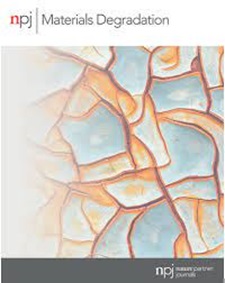采用XGBoost模型对应力腐蚀开裂进行定量评价
IF 7.6
2区 材料科学
Q1 MATERIALS SCIENCE, MULTIDISCIPLINARY
引用次数: 0
摘要
本研究采用数据驱动的方法来评估Fe-Cr-Ni合金在含氯化物环境中对应力腐蚀开裂(SCC)的敏感性。使用煮沸氯化镁恒负荷SCC试验的历史数据训练XGBoost回归模型。该模型克服了以往研究中出现的多重共线性和样本量不足的局限性。XGBoost模型捕获了合金成分与应力之间复杂的相互作用,解释了94.9% (R²= 0.949)的试样SCC敏感性。Shapley添加剂解释(SHAP)被用来解释模型,提供了新的冶金见解,如镍含量的关键作用。SHAP分析确定了最佳的镍含量范围在14.5 ~ 45%之间,显著提高了抗SCC能力。这项工作中的XGBoost-SHAP框架全面隔离了化学成分和压力的影响,为更系统化的合金设计提供了一条途径,摆脱了传统上对试验和错误或意外发现的依赖。本文章由计算机程序翻译,如有差异,请以英文原文为准。

XGBoost model for the quantitative assessment of stress corrosion cracking
This study employs a data-driven methodology to assess the susceptibility of Fe-Cr-Ni alloys to stress corrosion cracking (SCC) in chloride-containing environments. Historical data from constant-load SCC testing in boiling magnesium chloride were used to train an XGBoost regression model. This model overcomes limitations related to multicollinearity and insufficient sample sizes seen in previous studies. The XGBoost model captures complex interactions between alloy compositions and stresses, explaining 94.9% (R² = 0.949) of SCC susceptibility of the specimens. Shapley additive explanations (SHAP) were employed to interpret the model, offering new metallurgical insights, such as the critical role of nickel content. The SHAP analysis identified an optimal nickel range between 14.5 and 45 wt%, which markedly enhances SCC resistance. The XGBoost-SHAP framework in this work comprehensively isolates the contributions of chemical constituents and stress, offering a path toward more systematic alloy design—departing from the traditional reliance on trial and error or serendipity.
求助全文
通过发布文献求助,成功后即可免费获取论文全文。
去求助
来源期刊

npj Materials Degradation
MATERIALS SCIENCE, MULTIDISCIPLINARY-
CiteScore
7.80
自引率
7.80%
发文量
86
审稿时长
6 weeks
期刊介绍:
npj Materials Degradation considers basic and applied research that explores all aspects of the degradation of metallic and non-metallic materials. The journal broadly defines ‘materials degradation’ as a reduction in the ability of a material to perform its task in-service as a result of environmental exposure.
The journal covers a broad range of topics including but not limited to:
-Degradation of metals, glasses, minerals, polymers, ceramics, cements and composites in natural and engineered environments, as a result of various stimuli
-Computational and experimental studies of degradation mechanisms and kinetics
-Characterization of degradation by traditional and emerging techniques
-New approaches and technologies for enhancing resistance to degradation
-Inspection and monitoring techniques for materials in-service, such as sensing technologies
 求助内容:
求助内容: 应助结果提醒方式:
应助结果提醒方式:


